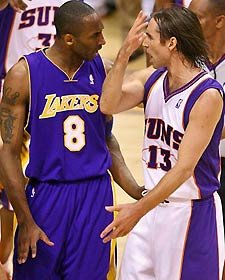We decided on 9 total categories so that we could balance our competition between the traditional big men (REB/BLK/TO/FG%) and small men(AST/STL/3PT/FT%) categories -- with PTS being the domain of everyone. Our goal is to make sure that a winning team will hypothetically be well balanced, just like an ideal NBA team should be. Real teams can't play winning basketball with five point guards or five centers, neither should our fantasy teams. Instead of using positional requirements, we hope our scoring will dictate balanced winning teams.
 With nine categories, balance can be paramount -- just like on a real NBA team. But one of the things we've experienced in the past is a genius strategy that concentrates on one type of player in order to make sure you win 5 of the 4 categories each week. While this team didn't necessarily produce championships, it was a force to be reckoned with.
With nine categories, balance can be paramount -- just like on a real NBA team. But one of the things we've experienced in the past is a genius strategy that concentrates on one type of player in order to make sure you win 5 of the 4 categories each week. While this team didn't necessarily produce championships, it was a force to be reckoned with.For our purposes, it's called the "small ball" team. Concentrating on just the four guard orientated categories (AST, 3PT, FT%, STL) and making sure to win PTS, a team can win handily each week by disregarding REB, BLK, FG% and TO.
The ideal small ball team would, of course, need a strong PG to provide ASTs and one of the scoring champions. In our current league, Nash and Kobe would be the ideal one -two combination. After those two, the needs are for another mid-range PG to provide some more ASTs and then all shooters for the rest of the roster. Big men who might provide provide REB/BLK/FG% are completely ignored as this team is about running and gunning.
The key here is to round out the roster with (relatively) cheap shooters who don't handle the ball much -- occassionally allowing the team to even win the turnover (TO) battle once in awhile when faced with certain matchups.
The upside of assembling this type of team is that most of the ideal players for this small ball system are often undervalued or overlooked. An ideal lineup here might look like: K Bryant, S Nash, Michael Redd, Jason Terry, Peja Stojakovic, Jameer Nelson, Wally Szerbiak, Kyle Korver, Ben Gordon, Cuttino Mobley
Notice the type of player that is perfect for this team. Aside from the main AST guys and the scoring star, you just pick shooters who can hit 3s, shoot accurate free throws, and don't touch the ball enough to never turn the ball over. It's not an intimidating lineup on paper, but it can be devastating on the court. You could call it the Glenn "Big Dog" Robinson of fantasy teams.

Note that the reverse of this strategy -- concentrating on the big men -- is much harder to do. Sure you could try to disregard guard-stat oriented players, but the overall shallow talent pool and steep drop-off after about 20 big men, makes the "big ball" strategy very hard to do. For example, the top 30 or so big men begins at Tim Duncan and ends at Danny Fortson (with Lamar Odom or Chris Webber in the middle). Many of the top big men have significant drawbacks, even discounting FT%, AST, STL, etc. Most of the big men who can score over 20 PTS a game will be long gone by the time you need them. Thus, it's much easier, and efficient, to field a squad of light, but accurate, shooters. Plus, as we all know from our first-hand basketball experience, it's so much more fun and demoralizing to bombs away (from 3-point land) and annihilate your opponent with precise missile strikes, ala the legendary Eric Agustin.
This primer is in no way meant to encourage or discourage a certain style of play, but it is meant to point out what is possible with our system, and to make sure everyone is aware that the initial balance of our 12-teams will be depend largely on recognizing what each individual owner is trying to do and keep that in context with what we are trying to do. We want to encourage variety in our team make-ups, but there is a slight potential for abuse of the system if a smart owner gets the opportunity and the motivation to field a small ball team.



0 comments :: Draft Primer
Post a Comment